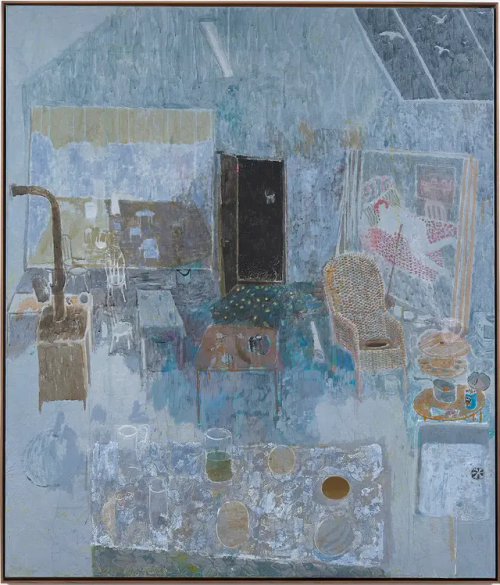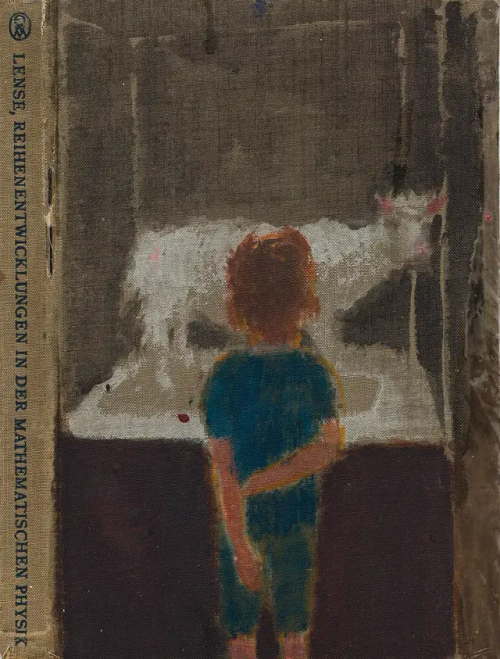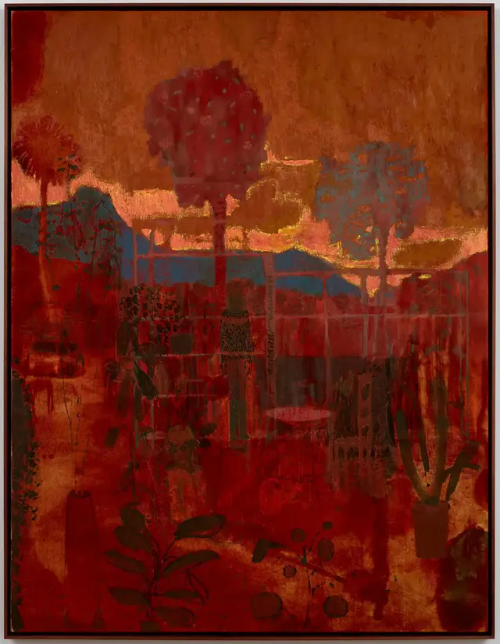Marcus Buck
Marcus Buck
The series "restarchitektur" is a long time project, I am still working on. The idea is to show architecture without showing architecture. The series is taken on large format. On big prints you can see the slight marks of bygone architecture. Onetime in form of a world map decorated from the inhabitant , another time as marks of stairs from a former staircase.




This reminds of lithography. After grinding down layers of limestone to create a clean surface for printing, a ghost image of a previous print can sometimes spontaneously surface as a reminder of the stone's past experiences.
More Posts from Caitlin-mcc03 and Others
Clarissa Sligh - What's happening with Momma?



Clarissa Sligh, What’s Happening With Momma? (Outside), 1987, Silk-screened with acrylic ink on 100% rag Coventry 320 gram soft white paper and 100% rag Stonehenge 250 gram cream paper.
What’s Happening with Momma? is a dimensional, house-shaped book that unfolds to tell an autobiographical story from the author. The book is shaped like her childhood home, a row house with steps where she sat as a child hearing scary noises coming from within. Sligh engages her viewers to walk through the rooms of this house to learn about her memories of her sister’s birth – her momma’s screams; her brother trembling; her rocking back and forth; the stork bringing her new sister.
Clarissa Sligh

Reframing the Past (1984-1994) could also be titled Re-Reading the Family Album. From 1984 to 1994, Sligh’s work centred on a re-investigation and re-evaluation of her family’s photo album. Growing up in the blue collar, black neighbourhood of Halls Hill in Arlington, Virginia in the 1950’s, keeping up the family album was something the artist took great pride in. Not realizing that her early family album project was created through the lens of a stereotypical white American family, she saw the project as making a record of positive images of her black family.

She Sucked Her Thumb, 1989, cyanotype, 27.5 × 21.5 cm (10 13/16 × 8 7/16 in.)



Therman Statom

Blue House, 2013.

Dos Sistemas, 2011.

Independence, 2024.

Ireland 2023 “I believe art can be understood both conceptually and intuitively. I think there is a need for the general public to come to an understanding that to appreciate art and creativity they must trust his or her self; that extensive education is not a prerequisite for understanding art. Much of what I do is seeded in what is more of an intuitive process; a large portion of my work is exploring these processes within people and their environments. The fact is, I believe that creativity is a part of all aspects of what people do; my studio and educational efforts via workshops and the support of outside programming, general educational and cultural institutions, are a reflection of this belief. I feel that art is tool for empowerment and education. It’s also a viable tool to investigate positive change and engage a culture through the use of exploration. ”

"Is it the fear of forgetting that triggers the desire to remember, or is it perhaps the other way around?" (Andreas Huyssen, Present Pasts: Urban Palimpsests and the Politics of Memory, 2003)
Christian Boltanski
In his installations and mixed-media works, Christian Boltanski uses photographs and found objects to question memory and individuality. An awareness of mortality, and of the general tenuousness of human existence, haunts his work. According to the artist, while individual memories might prove to be fragile, they are still filled with truthful yet unique values, making it the reason why he has often been choosing daily items as main creative elements to construct an archive of humanity

Christian Boltanski, Chance-The Wheel of Fortune, Installation View “Storage Memory”, Power Station of Art- Shanghai, 2018, Courtesy Power Station of Art

Christian Boltanski, Humains, Installation View “Storage Memory”, Power Station of Art- Shanghai, 2018, Courtesy Power Station of Art

Christian Boltanski, Personnes, Installation View “Storage Memory”, Power Station of Art- Shanghai, 2018, Courtesy Power Station of Art
In French, the word “Personnes” has dual meanings, referring to either “persons” or “nobody”. Here, the artist uses this double-edged word, which denotes presence but literally contains absence, to emphasise the inescapability of death and how chance watches over the destiny of each.
Celina Vleugels

How Can I become You series, 2019, Acrylic and embroidery on different fabrics

To the Temple of Childhood Memories, 2021, jacquard piece of an oil pastel drawing, wool and linen, 120 x 170 cm unique

Even when the season changes, you will always be rememembered. 2020, Industrial weaving combined with hand embroidery pieces 128cm x 145cm
Leo Gabin

Installation view, Independent Brussels, 2016
"In this age of the excessive use of images, for us it’s now more relevant than ever to use found footage and recycled imagery. Especially with an abundance of amateurish made “private” imagery put readily available online, the idea of authorship becomes even more questionable. But raising this question can be seen as the essence of the work."
-Leo Gabin, Modern Matter, June 2013
Now well known on the contemporary art scene, the Leo Gabin collective is interested in the thousands of images that form our visual and virtual, common and quotidian landscape. Internet represents a window onto the world where images of all kinds circulate and cohabit, providing a mass of information that must be deciphered. By appropriating these visions, the collective creates new works that capture this incessant movement on canvas, in silkscreen prints, videos and installations. Today, when everybody is an author and is helping enrich this virtual universe, the works of art elaborated by the trio attain a new dimension.
In them, techniques and materials combine yet always leave the original image, the creative source, visible. Leo Gabin is particularly interested in American culture, so important in the three artists’ young years. It stages the stereotypes, excesses and paradoxes to which it can give rise.
https://contemporary-art.mirabaud.com/en/artists/detail/leo-gabin

Further on Grand Ave, 2016,
Lacquer and acrylic on aluminum,
75 5/8 x 53 1/8 inches (192 x 135 cm)

At It Again, 2014 Lacquer, spray paint, acrylic and silkscreen on canvas 205 x 150 cm (80.71 x 59.06 in)
Rob Swainston - Printstallations

PLEXUS (2011), woodblock print on paper with mirrors.

In Front of Behind the Wall, (2011), woodblock print on paper.

Zimmer Frei, (2012), woodblock print on fabric with wood and wire.
Rob Swainston reminds us we are not just consumers of icons, but producers and observers of images. All images are historically negotiated assemblages between humans, machines, materials, and social structures. In a society where social knowledge and power have become pure image, the print technologies historically central to this transformation can act as double-agent. Artists working in print media can be chameleons moving between image makers and image reproducers. Image reproducers are technocrats, proto-machines, and images-smiths in building the spectacle world order. In their perfection they ask no questions. Artists are image makers showing an image constructed, built, repeated, overprinted, coded, decoded, and endlessly negotiated. For the printmaker, the press bed is not a window of illusion, it is the space of social tinkering. The artist is a hacker. Rob Swainston performs this hack through two interrelated bodies of work—series of unique multiples and printstallations. Installations such as ‘A New System Every Monday’ and ‘All that is Solid Melts into Air’ mix print media, sculpture, painting, drawing and video to point out architectural, institutional, historical, and social spaces. Series of standardized works such as ‘Who Owns the Sky?’ and ‘Propositions’ move between representation and abstraction such that neither of these categories are important. The viewer participates in an “archeology of uncovering”, discerning numerous processes and images containing multiplicities of narratives culminating in an uncovering of the “significant image” and the realization “I see myself seeing myself.”
Andrew Cranston


Aberdeen Studio (My Blue Period), 2023, distemper on canvas, 212.9 x 182.4 cm, 83 7/8 x 71 3/4 in
Andrew Cranston’s figurative paintings are steeped in atmosphere; their fragments of narrative quickly dissolving into dreamlike visions of objects awash in colour, shape and texture. His works often depict domestic interior spaces – in a not-so-distant echo of the arrangements of classical still lives – but where such ordinary things as windows, items of furniture, and ornaments become conduits for far more uncanny formal explorations. Abandoned tables, libraries, tents and private chambers are just some of the scenes in which Cranston’s expansive imagination takes shape, drawing from his lifelong interest in storytelling through colour and form. His works take two distinct formats: large scale canvases worked in distemper and oil, and smaller paintings executed directly on hardback book covers. Often his paintings revel in a single colour field, whether oceanic blues, ruddy ochres, or blazing scarlets, within which his dreamlike worlds unfurl through the expressive treatment of surfaces. Their atmospheres flicker between the private and the theatrical, the picturesque and the chaotic, abundance and solitude, each in their own way beckoning the viewer deeper into their worlds.

Rudy and Dolly, 2024, oil on hardback book cover, 23 x 17.2 cm, 9 x 6 3/4 in

Stay with me, my nerves are bad tonight, the midges too, 2022, distemper and oil on canvas, 170.3 x 130.2 cm 67 1/8 x 51 1/4 in
Chiharu Shiota
"Everything I create is from a personal experience but I want to extend it into something universal." Stepping into one of Chiharu Shiota’s striking installations is like entering an alternate reality: the materials and objects feel familiar, but the logic behind the intricate web structures seem to stem from an unknowable realm. Enveloped in an elaborate web of yarn, you’re left with a subtle, indescribable imprint on the body and mind.

The Key in the Hand, 2015. Installation: old keys, wooden boats, red wool. Japan Pavilion at 56th Venice Biennale, Venice, Italy For the 56th Venice Biennale, Shiota unveiled ‘The Key in the Hand' (2015), a piece created for the Japanese pavilion. In this installation, 180,000 keys gathered through an open call were suspended from dense webs of red yarn, which linked the gallery space to two wooden boats on the floor. A photograph of a child holding a key was displayed alongside four monitors featuring videos of young children talking about memories before and after they were born. For the artist, keys are a personal object that simultaneously keeps our space safe on a daily basis and has the potential to unlock doors to new, unknown worlds. The keys dangling from thousands of red strings evoked a sense of intercon-nectedness and expansiveness, allowing viewers to imbue their own memories and associations to the familiar everyday item.

Counting Memories, 2019. Installation: wooden desks, chairs, paper, black wool. Muzeum Śląskie w Katowicach, Katowice, Poland For ‘Counting Memories’ (2019), an installation shown at Muzeum Śląskie in Katowice, Poland, the artist envisioned a network of black yarn extending from the ceiling to be a night sky, or a universe, filled with white numbers dotting the space like stars. The piece invited viewers to sit at desks (also entangled in black yarn) where they had the opportunity to answer questions and contemplate the significance of numbers in their lives: Numbers that have special meaning, numbers in the form of dates, numbers connected to personal histories. As with many of her works, the installation attempted to make visible the invisible threads shaping our inner and outer lives.

Chiharu Shiota – A Room of Memorya, 2009, old wooden windows, group exhibition Hundred Stories about Love, 21st Century Museum of Contemporary Art, Kanazawa, Japan
